Hawaii has some of the most beautiful landscapes in the world and offers something for everyone, from Maui’s mountainous terrain to Kauai’s lush rainforests.
In addition to its natural beauty, the Aloha State is also home to many wildlife, including extremely rare and endemic species including Hawaii’s native duck, the Hawaiian Duck.
Ducks are some of the most common birds found in Hawaii. They can be seen in nearly every body of water on the islands. These waterfowl particularly love the state’s warm climate and ample food supply.
What Ducks Are in Hawaii?
There are 30 species of ducks in the state of Hawaii.
Bufflehead
Canvasback
Cinnamon Teal
Common Goldeneye
Falcated Duck
Gadwall
Garganey
Hawaiian Duck
Mallard
Northern Shoveler
Redhead
Ring-Necked Duck
Hawaii, with its stunning landscapes and unique island ecosystems, offers birdwatchers and nature enthusiasts an unparalleled opportunity to observe a variety of intriguing waterfowl. The isolated location of the Hawaiian Islands has given rise to several endemic duck species, making it a truly exceptional destination for duck watching.
While Hawaii is not bordered by any neighbouring states, you may consider venturing to the mainland United States to explore the fascinating world of ducks in other regions. On the west coast, you can discover the diverse duck species of California and appreciate the state’s rich wetland habitats.
Further inland, the bountiful duck populations of Nevada can provide a captivating experience, as you explore the unique ecosystems that support these beautiful birds. By extending your birdwatching journey beyond Hawaii, you can gain a deeper understanding of the diverse world of ducks found throughout the United States.
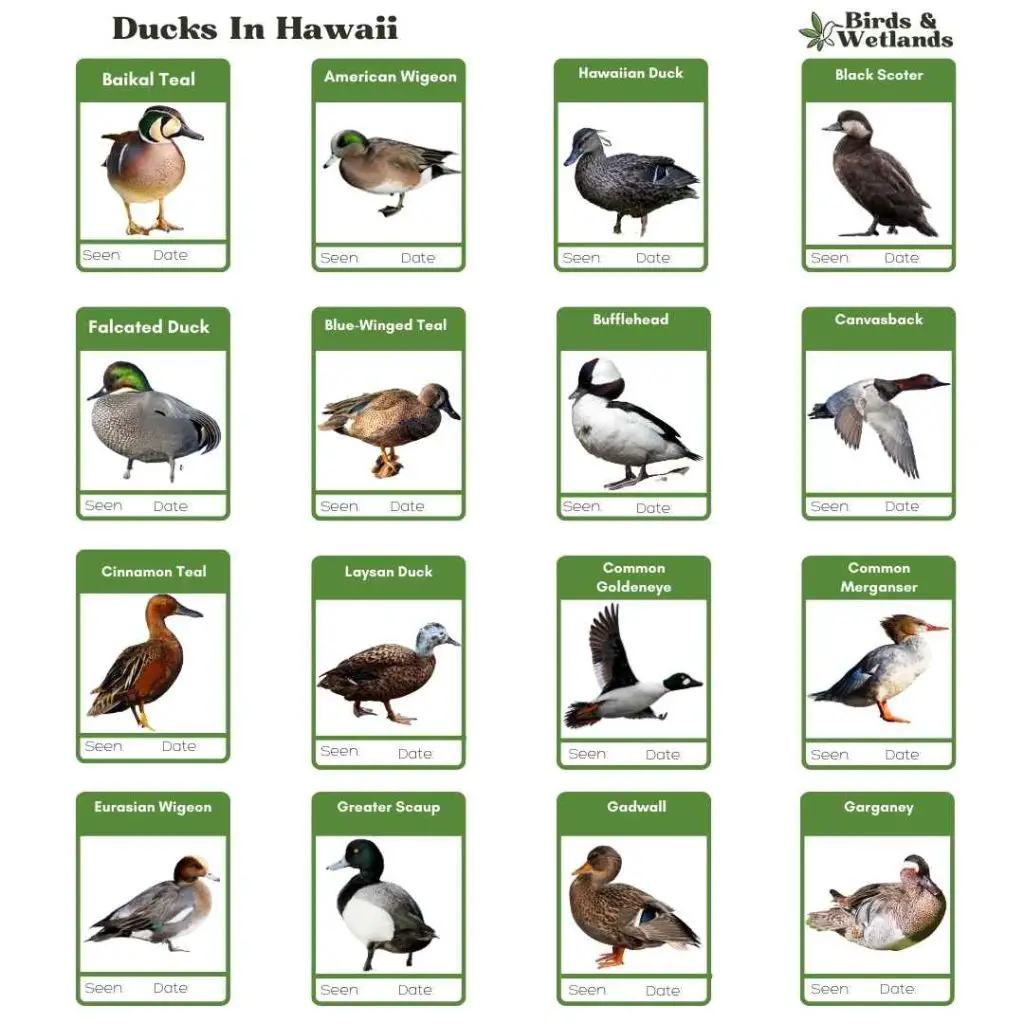
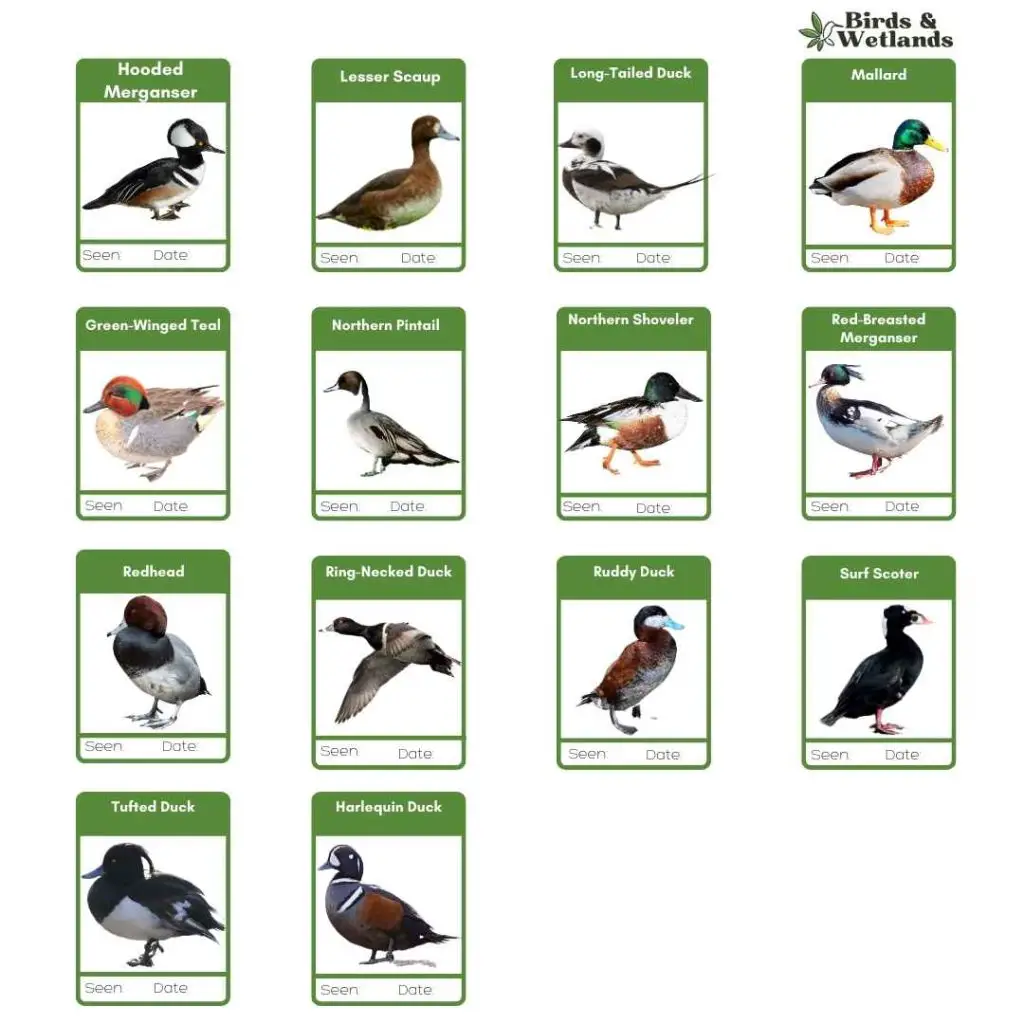
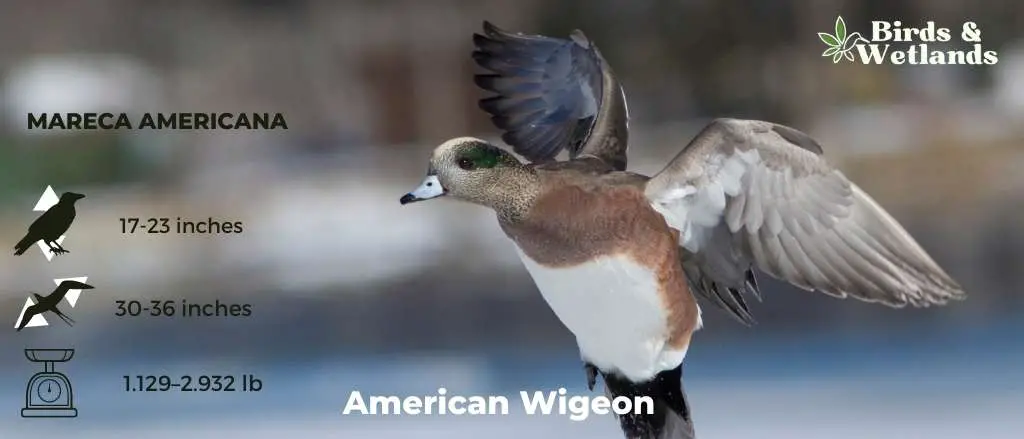
American Wigeon
Listen to American Wigeon
The American Wigeon is a dabbling duck found in North America. It is a medium-sized duck that is larger than a teal but smaller than a pintail. It is different than other North American dabblers with its round head, small bill and short neck.
Males have a distinct green stripe behind the eyes, a white crown and mostly brown bodies. Females have a dark smudge around the eyes, brownish-gray heads and warmer brown bodies.
The American Wigeon is common and widespread in North America. They breed in all regions of the continent except for the northern regions of Canada and Alaska. Most of the population of these ducks breed in wetlands in boreal forests and subarctic river deltas of Alaska and Canada.
During winter, many American Wigeons travel through the major flyways, they are most numerous on the Pacific Flyway. They spend winters in California’s Central Valley, Louisiana’s Gulf Coast and Texas Panhandle. Some flocks of wintering American Wigeons fly further south in the Caribbean.
As dabbling ducks, the American wigeons feed by dabbling and grazing but they are mostly found feeding on dry land. They eat grains, seeds, grasses, wheat and lettuce.
Scientific Name: Mareca americana
Height: 42–59 cm (17–23 in)
Wingspan: 76–91 cm (30–36 in)
Weight: 512–1,330 g (1.129–2.932 lb)
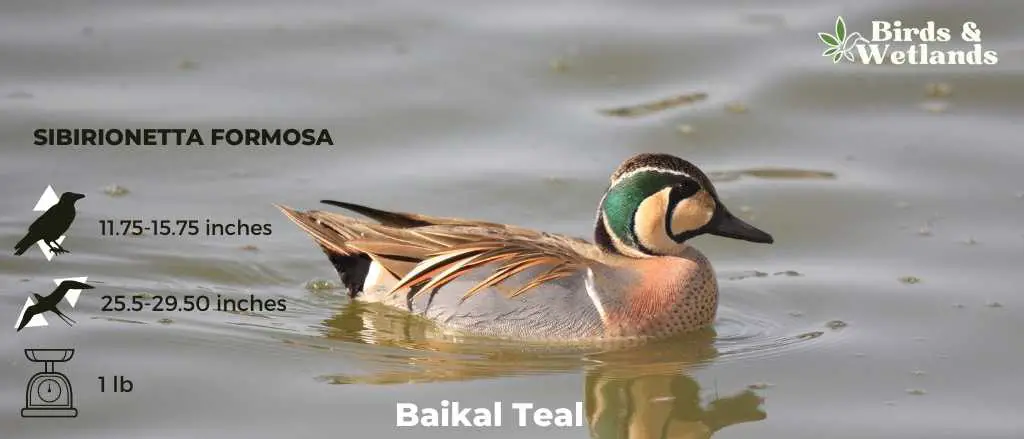
Baikal Teal
Listen to Baikal Teal
The Baikal Teal is a small duck that has a long, slender bill with a black tip, and its tail is short and slightly rounded. The male’s head and neck are blue-gray, and the rest of the body is an olive color with darker brown stripes. The female’s head is brownish gray, and its body is grayish-green with light brown markings.
Baikal teals can migrate thousands of miles each year to follow their food supply; they spend winters in coastal areas where they feed on marine life like fish eggs and crustaceans. They also eat small fish when necessary to survive harsh winters when there are no other food sources available for them to eat. They eat seeds from aquatic plants and insects found in lakes or ponds during their migration periods.
Baikal Teals are migratory birds that travel between Siberia, Alaska, and Canada during their breeding season. During the winter months, they can be found in China and Japan.
It is currently listed as “Least Concern” by the IUCN Red List due to its large population size and stable population trend.
Scientific Name: Sibirionetta formosa
Height: 11.75 to 15.75 inches
Wingspan: 65–75 cm
Weight: 1 pound
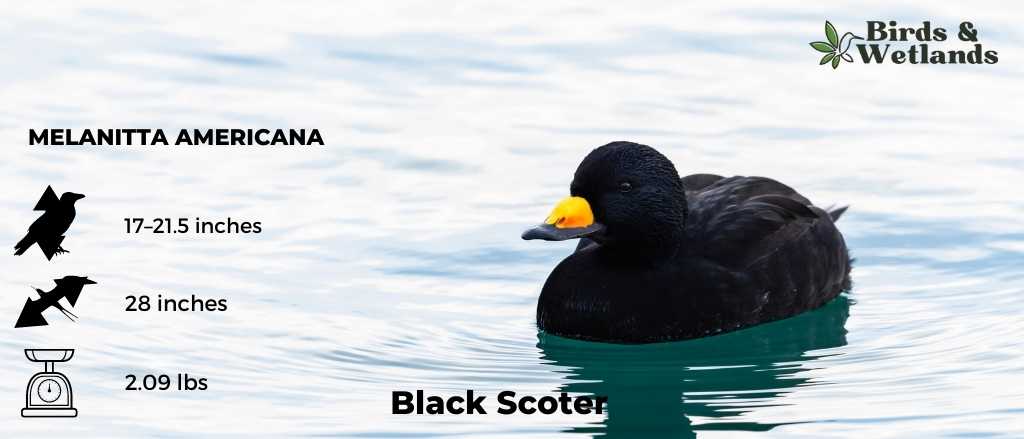
Black Scoter
Listen to Black Scoter
The black scoter, also known as the American scoter, is a relatively large sea duck with an average length of 49 cm (19 in). It has a bulky shape and a large bill.
Adult Males have an all-black plumage on both body and head except for the yellow knob at the base of their large bill. Females have smaller bills, brown bodies with pale faces.
Black scoters live near saltwater, ponds and small lakes. They breed in the northern regions of North America, particularly in Newfoundland, Labrador, and the northwest and southeast parts of Hudson Bay. Some flocks of black scoters breed in scattered locations east of Yana River on the Siberian side of the Bering Strait. During winter, they form large flocks of other wintering scoter specie and migrate south.
Black scoters dive underwater for mollusks, crustaceans and shellfish. They occasionally feed on vegetation such as duckweed.
Scientific Name: Melanitta americana
Length: 430–550 mm (17–21.5 in)
Wingspan: 710 mm (28 in)
Weight: 950 g (2.09 lb)
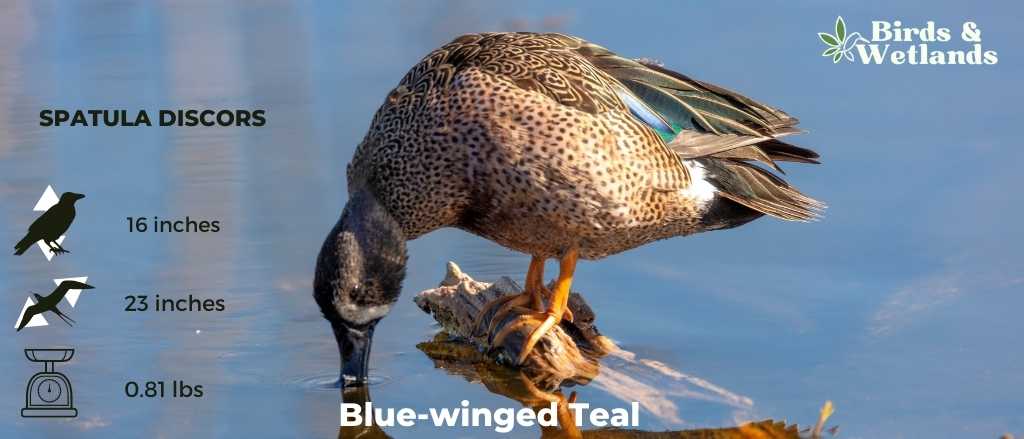
Blue-winged Teal
Listen to Blue-winged Teal
The Blue-winged Teal is a small duck that lives in North America.
Breeding males have a glossy blue-gray head with a white crescent-shaped patch in front of the dark eyes. They also have black wings and rears.
Females have mostly brown bodies with black bills, dark caps and eyeliners on the head.
The Blue-winged Teal’s diet consists mostly of aquatic plants like pondweed, but it will also eat insects when they are available. This duck often feeds by pecking at the surface of the water rather than diving for food. It will sometimes form small groups to feed together or fly in single file formation when migrating south for winter.
Blue-winged teals are found in marshes, ponds, lakes, and rivers throughout the United States south of Canada, and north of Mexico.
They are migratory birds and fly south for the winter months to warmer climates. It winters along the Atlantic coast from southern New England to Virginia and then moves further south as far as Mexico.
Scientific Name: Spatula discors
Height: 40 cm (16 in)
Wingspan: 58 cm (23 in)
Weight: 370 g (13 oz)

Bufflehead
Listen to Bufflehead
Buffleheads are striking ducks. They are small ducks with relatively large heads.
Males have a huge white patch on their iridescent purple-green heads. They also have short dark bills, white chests and flanks.
Females have a distinct white patch on the cheeks, rounded heads and brownish bodies.
Buffleheads breed in boreal forests and taigas of Alaska and Canada. They migrate to the southern parts of the United States, settling near coastal and open inland waters. Some flocks even travel as far as western Europe.
Buffleheads are diving ducks that dive underwater to forage for food. They primarily feed on small aquatic insects, crustaceans and mollusks. They also consume aquatic plants and fish eggs occasionally.
Scientific Name: Bucephala albeola
Length: 32–40 cm (13–16 in)
Wingspan: 21.6 in (55 cm)
Weight: 270–550 g (9.5–19.4 oz)
Canvasback
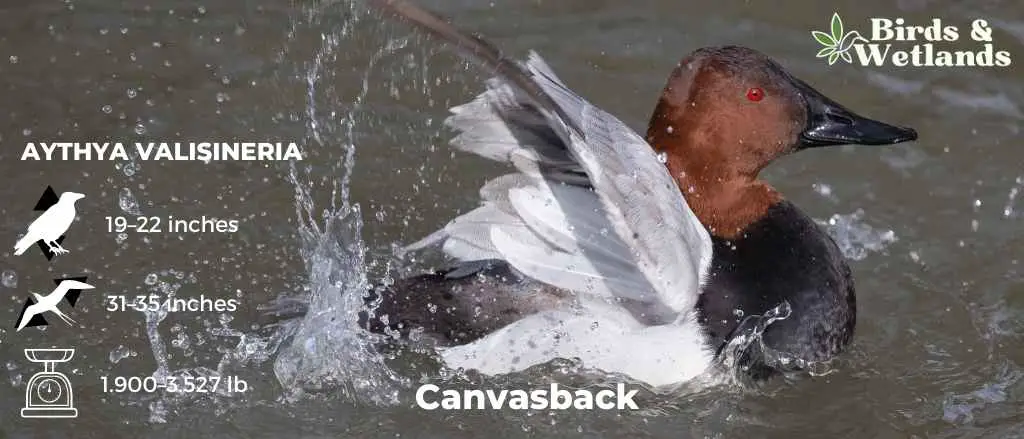
Canvasback
Listen to Canvasbacks
Canvasbacks are large diving ducks with sloping foreheads and dark bills. The male has red eyes, a black chest and a white body. The female has black eyes, a brown head and a pale gray body.
Breeding populations of canvasbacks are found scatted all over the North American prairie potholes and the subarctic river deltas of Saskatchewan and Alaska. These ducks prefer to nest over or near prairie marshes surround by protective vegetation such as bulrushes and cattails.
Canvasbacks are diving ducks which means they feed primarily by diving underwater. They eat a variety of plant materials such as grass seeds, leaves, tubers, roots and buds. They prefer sago pondweed tubers which consist 100% of their diets at times. These waterfowl also feed on snails, insect larvae and small fish.
Scientific Name: Aythya valisineria
Height: 48–56 cm (19–22 in)
Wingspan: 79–89 cm (31–35 in)
Weight: 862–1,600 g (1.900–3.527 lb)
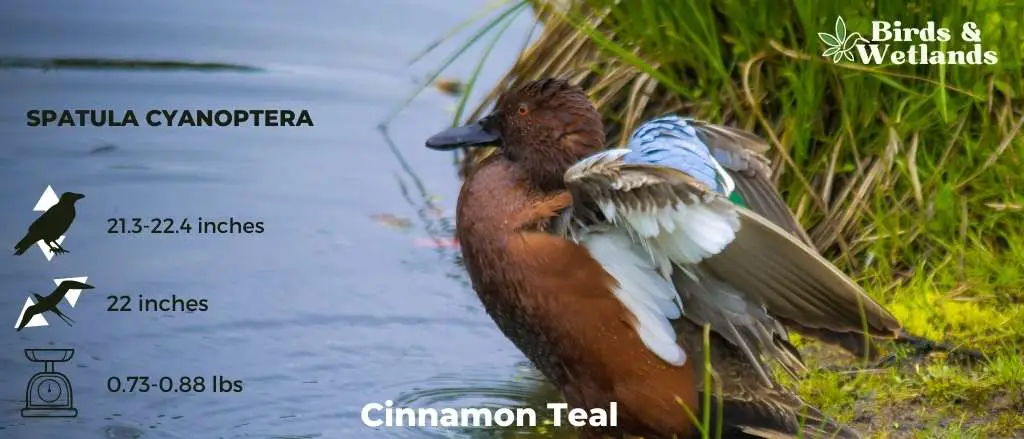
Cinnamon Teal
Listen to Cinnamon Teal
Cinnamon Teal is a small duck with distinctive bright cinnamon-colored feathers on its back and white markings above the eye that is native to North America and Central America.
The diet of this bird includes seeds, insects, and other invertebrates that are found near water sources where they live. Like most ducks, it feeds on aquatic vegetation such as pondweed, watercress, pondweed, and water lilies. This bird has also been known to eat insects and small crustaceans.
They are found in the northern hemisphere and are particularly common in North America, where they breed from Alaska to Canada. They winter south of the U.S., as well as in parts of Mexico and Central America.
The Cinnamon Teal is a very social bird, often living in large flocks during the breeding season and congregating around lakes and rivers during migration. They tend to be shy and elusive, so it can be difficult to see them in their natural habitat.
These birds mate for life and build nests on the ground near water sources—usually shallow ponds or marshes with tall grasses nearby for cover when young are being reared.
Scientific Name: Spatula cyanoptera
Height: 21.3-22.4 in (54-57 cm)
Wingspan: 22-inch (560 mm)
Weight: 11.8-14.1 oz (335-401 g)
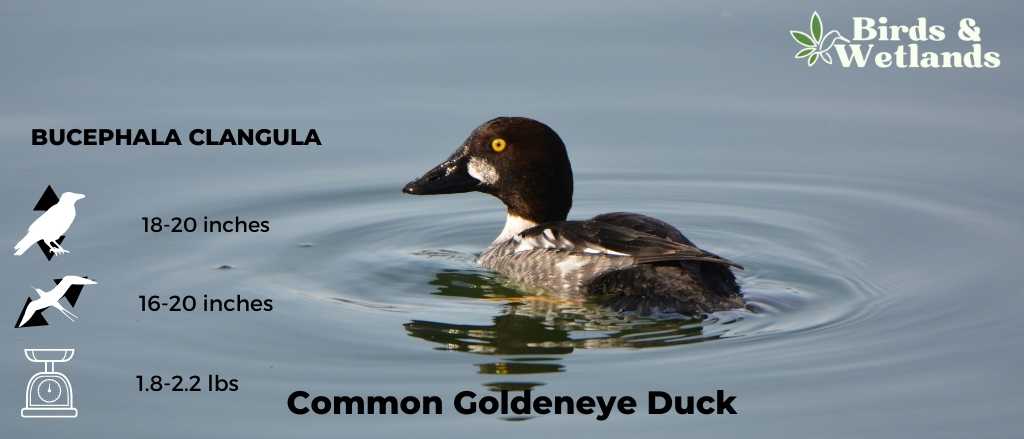
Listen to Common Goldeneye Duck
The Common Goldeneye Duck is a medium-sized diving duck that breeds across the northern hemisphere in North America, Asia, and Europe. It winters in the southern hemisphere.
Males have dark green heads with bright yellow eyes. They also have a distinctive white cheek patch. Their bodies are white with black back and rump.
Females have dark brown heads but with a short dark bill with a yellow tip at the end. They have grayish bodies, a white neck collar and pale yellow eyes.
Common Goldeneyes are also known for their unique calls. It sounds like a squeaky rubber toy being squeezed repeatedly. This makes them easy to identify by ear in addition to sight!
As one of North America’s most abundant ducks, Common Goldeneyes live in lakes, ponds, rivers, and marshes. Most of these ducks also live near shorelines where there is plenty of fish and vegetation available for food sources.
The Common Goldeneye Duck is listed as “least concern” by the International Union for Conservation of Nature (IUCN), which means that it isn’t threatened with extinction
Scientific Name: Bucephala clangula
Length:
Male: 45–51 cm (18–20 in)
Female: 40–50 cm (16–20 in)
Wingspan: 30.3-32.7 in (77-83 cm)
Weight:
Male: 1,000 g (2.2 lb)
Female: 800 g (1.8 lb)
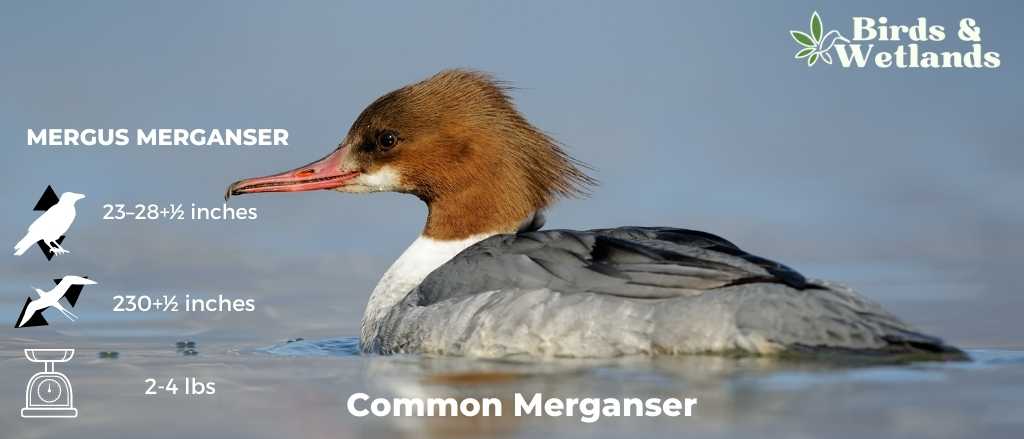
Common Merganser
Listen to Common Merganser
Common Mergansers are fairly large ducks with long slender bills, with different tip colors depending on gender. Males have black tips while females have brown tips.
Breeding males have long, large white bodies with a Mallard-like green head.
Females and non-breeding males have a ragged crest atop a warm cinnamon-colored head.
Common mergansers are omnivores, eating both plants and animals such as small fish or insects. They eat their prey by diving underwater and spearing it with their long bill before swallowing it whole.
The habitat of this bird is lakes, rivers, ponds, and marshes. They prefer quieter bodies of water with plenty of vegetation along the shores where they can rest during the day before moving on to hunt at night.
The current population of this bird is considered stable due to its ability to thrive even when there are threats present due to its adaptability as well as its wide range across North America.
Scientific Name: Mergus merganser
Length: 58–72 cm (23–28+1⁄2 in)
Wingspan: 78–97 cm (30+1⁄2–38 in)
Weight: 0.9–2.1 kg (2 lb 0 oz – 4 lb 10 oz)
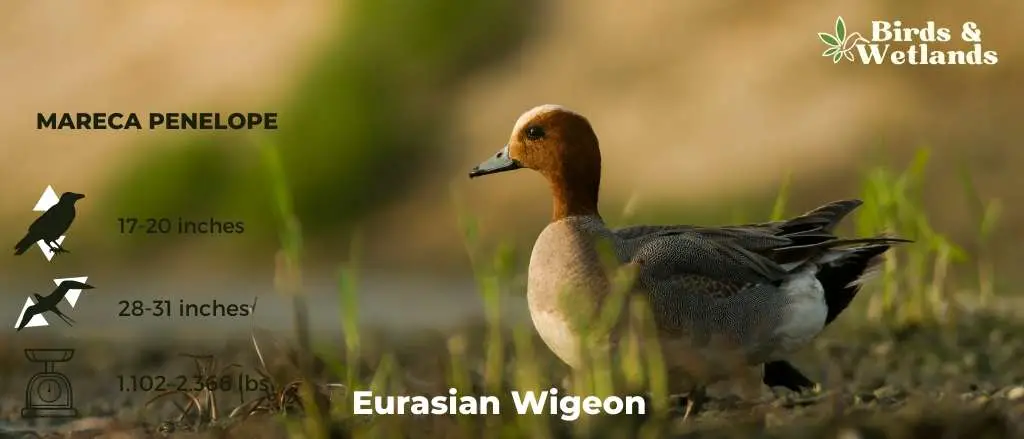
Eurasian Wigeon
Listen to Eurasian Wigeon
The Eurasian wigeon, or European wigeon, is a dabbling duck widespread in the Palearctic. It is a rare visitor in the United States, with a non-breeding population that spends winters in various parts of the country except for the southern Appalachian region and the Four Corners.
Males have bright rufous-brown heads and buffy crowns that contrast their gray bodies. Females have mostly brown bodies with white bellies.
Eurasian wigeons nest near water and usually under cover of tall vegetation. They inhabit wet grasslands and marshes.
Eurasian wigeons breed in the Palearctic, northern parts of European and Russia. These birds migrate south to southern Asia and Africa for the winter. There is a small breeding population in Scotland that spends winters in Great Britain and Ireland.
Eurasian Wigeons eat mainly aquatic and terrestrial plants. Their diet consists of leaves, stems, roots, and seeds. They often feed on grasses, grains, seeds, duckweed, cattail, sedge and water milfoil. They are also known to feed on grains such as rice, wheat and barley. In addition to their main diet, they also occasionally eat mollusks, crustaceans, small fish, mayflies and beetles.
Scientific Name: Mareca penelope
Height: 42–52 cm (17–20 in)
Wingspan: 71–80 cm (28–31 in)
Weight: 500–1,073 g (1.102–2.366 lb)
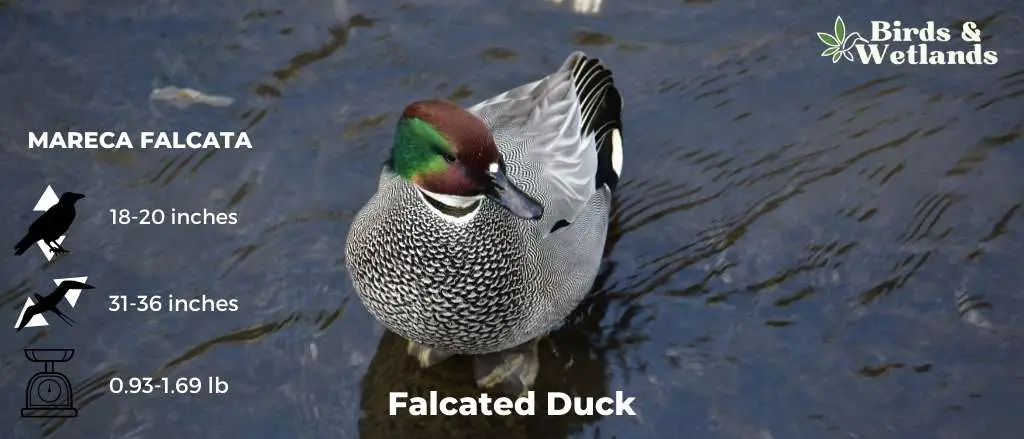
Falcated Duck
The Falcated Duck is a species of duck that lives in the wilds of North America, Canada, and Alaska making its home in the Pacific Northwest.
It has long legs and wings, making it one of the fastest ducks on earth. Its bill is also distinctive, with a downward curve at the end. Their legs are pinkish-grey and they have reddish-orange eyes. Their bills are a yellowish-green color with black tips. They also have a white stripe down their neck to their chest.
They’re omnivorous – eat aquatic plants and seeds, and animals. but on average they eat about 70% animal matter (like insects and small fish). It forages for food by diving underwater or dabbling at the surface, sometimes upending completely to reach roots or plant stems growing close to the surface of the water.
This duck is notable for its very distinctive bill and its unusual nesting habits—instead of building a nest that it sits on, this duck lays its eggs in shallow water and lets them incubate naturally. They are very social animals and live in small groups called “trios” or “flocks” during the breeding season (which lasts from mid-April to early July).
The breeding range of the falcated duck is from eastern Siberia and Mongolia to northeastern China and northern Japan with wintering grounds in the northern part of southeast Asia to northeastern India.
The Falcated Duck is a globally threatened species due to hunting pressure from humans who seek its meat as well as habitat loss due to drainage of lowland wetlands where they breed and overwinter.
Scientific Name: Mareca falcata
Height: 46 to 53 cm (18–21 in)
Wingspan: 79 to 91 cm (31–36 in)
Weight: 422 to 770 g (14.9–27.2 oz)
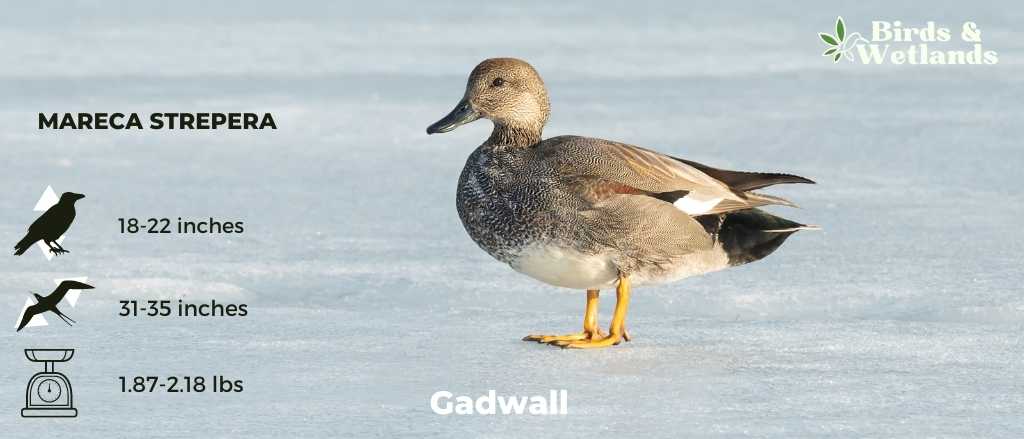
Gadwall
Listen to Gadwall
The Gadwall is a common dabbling duck with breeding populations in northern parts of North America, Europe and Russia.
Males have overalls of an intricate pattern of gray, brown and black. They have dark bills. Females resemble female mallards with mottled brown bodies.
The gadwall nests on the ground near open wetlands with dense vegetation such as steppe lakes, marshes and wet grasslands.
Gadwalls are migratory birds. Their North American population spends winters in the southern parts of the United States, Mexico and Central America.
Gadwalls are omnivores. They primarily eat submerged vegetation such as grasses, pondweed, algae, and water milfoil. They also eat snails, water beetles and other small invertebrates.
Scientific Name: Mareca strepera
Height: 46–56 cm (18–22 in)
Wingspan: 78–90 cm (31–35 in)
Weight
Male: 990 g (35 oz)
Female: 850 g (30 oz
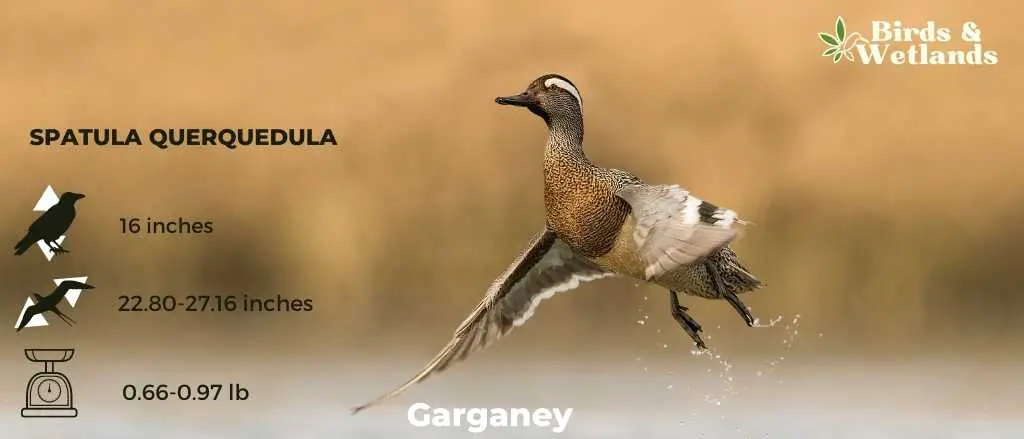
Garganey
Listen to Garganey
Garganey is a small duck with a slender body, long neck, and short bill. It has a black head, neck, and upperparts. The breast is white with dark spots in the center of each feather. The flanks are brownish-gray and the belly is white. The legs and feet are yellow orange.
The Garganey feeds on insects, mollusks, fish, frogs, and worms. It nests near water, where it can be seen diving for food with its bill pointed downward.
The garganey’s habitat includes shallow freshwater lakes, ponds, and marshes with reeds or other tall vegetation near them. They live in flocks during the breeding season but tend to be solitary during migration and winter months.
It breeds over most of Europe and the Palearctic, as well as northern Asia and North America but it is purely migratory, with the whole population migrating to Southern Africa, India, Bangladesh, and Australasia during the Northern Hemisphere winter, when vast flocks may be seen.
The garganey is listed as Least Concern by IUCN due to its large range estimated at 1 million km2 (390 000 mi2).
Scientific Name: Spatula querquedula
Height: 41 cm
Wingspan: 58 – 69 cm
Weight: 300- 440 g
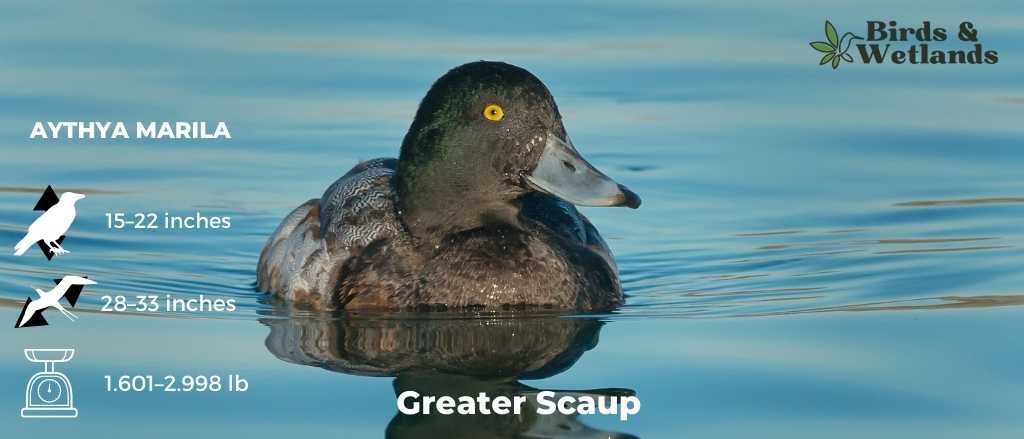
Greater Scaup
Listen to Greater Scaup
The Greater Scaup is a large diving duck with a distinctive white band on its head. The rest of its body is brown with a blue-grey sheen on its back and tail (which can be seen when they fly). The male is larger than the female, with a more pronounced bill and more white wing feathers. It has a black bill, black feet and legs, and gray plumage.
They prefer shallow water close to shore where they can feed on aquatic vegetation and small fish. They are omnivorous creatures who feed on mollusks, crustaceans, insects (especially water beetles), worms, and other small invertebrates like larval dragonflies which comprise about 60% of their diet.
This species breeds in the northern taiga regions of Canada and Alaska and winters in the Atlantic and Pacific Oceans, as well as some inland lakes. It is an uncommon sight in North America but can be found in many areas across Europe, Asia, Africa, and Australia. In winter, it migrates to southern Canada and parts of the northeastern United States.
Scientific Name: Aythya marila
Height: 39–56 cm (15–22 in)
Wingspan: 71–84 cm (28–33 in)
Weight: 726–1,360 g (1.601–2.998 lb)
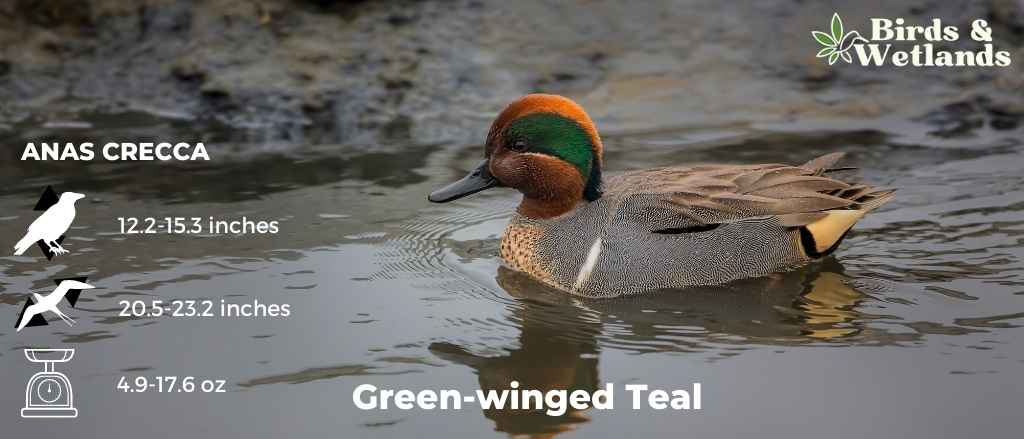
Green-winged Teal
Listen to Green-winged Teal
Green-winged Teals are among the most common ducks in the northern regions of North America except on the Aleutian Islands. They are the smallest dabbling ducks on the continent.
Breeding males have chestnut-colored heads with a green streak behind the eye. They also have gray-barred bodies with a vertical white stripe on the sides.
Females have a mottled brown plumage, similar to that of female Mallards. They have a dark eye-line.
You can easily identify birds in the wild. Both males and females have a green patch on the wings which are hidden often hidden while they are resting but visible when in flight.
Green-winged Teals breed in the northern parts of North America. Breeding populations of these ducks are found in the Aleutian Islands, northern Alaska, northern Saskatchewan and other northern Canadian provinces.
Green-winged Teals primarily eat plant matter such as seeds, stems and leaves. They also consume grains such as millets, wheat, corn and barley. They occasionally feed on mollusks, crustaceans, maggots of decaying fish and insects. They search for food on mud flats, shallow marshes and flooded agricultural lands.
Scientific Name: Anas crecca
Height: 12.2-15.3 in (31-39 cm)
Wingspan: 20.5-23.2 in (52-59 cm)
Weight: 4.9-17.6 oz (140-500 g)
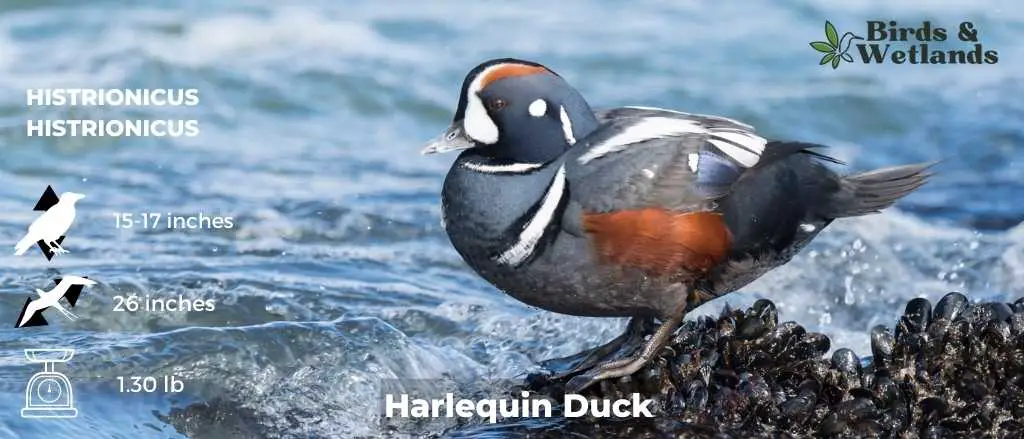
Harlequin Duck
Listen to Harlequin Duck
The Harlequin Duck is a beautiful small sea duck that is native to North America. It has a unique appearance. It has a black head, neck, and breast, with white cheeks and sides of the neck, and red eyes. The body is black with white spots on the wings and tail feathers.
In addition to being unique-looking birds, Harlequin Ducks are also very vocal animals who make sounds such as whistles and squeaks that can be heard from up to 100 yards away! These sounds are used primarily for communication between other ducks within a flock but can also be used to alert predators of danger if needed (such as when approaching land).
These birds feed on small fish and crustaceans such as shrimp and clams. They can dive up to 20 feet below the surface to catch their prey.
It can be found in coastal areas of North America, Europe, and Asia, where it lives in salt marshes. It lives in freshwater lakes, ponds, and rivers. The species is monogamous and breeds in April and May.
Unfortunately, these beautiful creatures are currently under threat from habitat loss due to human development as well as overfishing.
Scientific Name: Histrionicus histrionicus
Length: 15–17 in (380–430 mm)
Wingspan: 26 in (660 mm)
Weight: 600 g (1.3 lb)
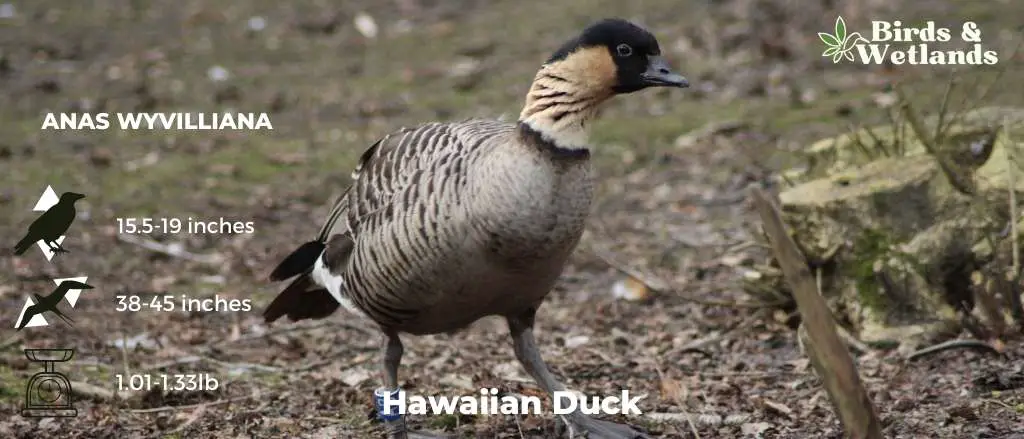
Hawaiian Duck
Listen to Hawaiian Duck
The Hawaiian Duck, also known as the Koloa, is a dabbling duck that is endemic to the Hawaiian Islands of Big Island, Maui, Kauai, Oahu and Niihau. Formerly, Hawaiian duck population can be found in all of the Hawaiian islands except Lanai.
According to legend, the Hawaiian duck served as a guide to Imaikalini, a fierce blind warrior king.
Male and female Hawaiian ducks are similar in appearance, with only a few differences. Both genders share blue-green speculum feathers with white borders on each side. Their tail feathers are mostly dark, with orange feet and legs.
An adult male is generally bigger than a female. The bill is olive green in the male and dull orange in the female. The male has a darker head while the female has plainer back feathers.
The Hawaiian Duck lives in river valleys, marshlands, freshwater ponds, streams, lakes and other wetland habitats with plenty of covers such as tall wetland grasses or reeds. They are omnivorous animals that mainly feed on freshwater vegetation, insects, mollusks, mosquito fish, mosquito larvae and other aquatic invertebrates. These water birds also consume snails and green algae.
Some pairs nest year-round, while others get together during their breeding season, which is usually from December to May. The female lays two to ten eggs in a well-concealed nest lined with down and breast feathers. Unfortunately, due to hybridization, there are fewer pure Hawaiian ducks. Hawaiian ducks and mallards are closely related. They have been observed to interbreed and can produce viable offspring.
Human disturbance, non-native invasive plants, introduced fish, predation by feral cats, environmental destruction and introduced predators such as small Asian mongooses are the main cause of the decline of the population of this now endangered species. Destruction of their habitat to make way for hotels and golf courses as well as previous hunting have contributed to their population decline. There only 2,200 estimated living Hawaiian ducks.
Conservation efforts to increase the Hawaiian duck’s population include removing feral mallards from suitable ponds, lakes and other wetlands. This has been done due to the Hawaiian duck’s behavior. They are very secretive birds and don’t live with other animals.
Scientific Name: Anas wyvilliana
Height:
Male:48–50 cm (19–19.5 in)
Female: 40–43 cm (15.5–17 in)
Wingspan: 97-114 cm (38-45 in)
Weight:
Male: 604 grams (21.3 ounces)
Female: 460 grams (16 ounces)
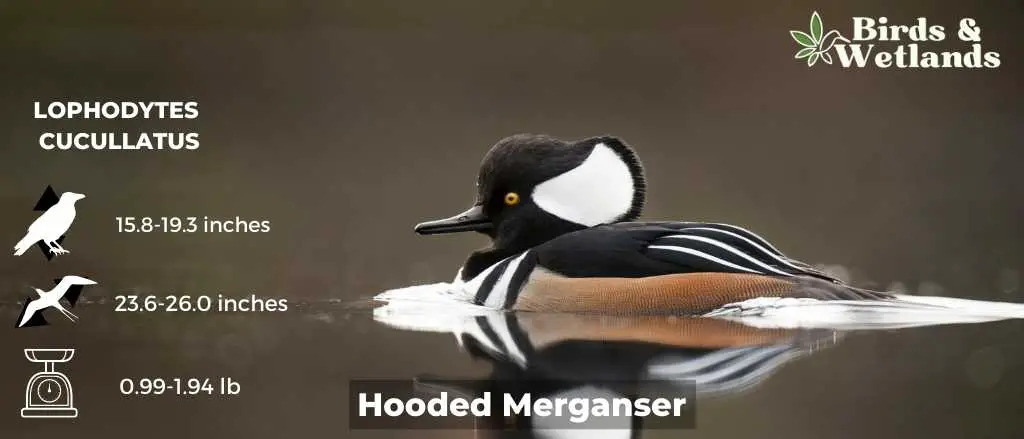
Hooded Merganser
Listen to Hooded Merganser
The Hooded Merganser is a relatively small duck with a slender body and a long tail.
Breeding males have a large black crest with a large white patch on each side. They also have golden yellow eyes.
Females have brown bodies with a slightly lighter colored crest which looks like a mohawk. They have dark eyes.
Non-breeding males look similar to females but with yellow eyes.
Hooded mergansers live in North America and spend most of their time in freshwater ponds, lakes, estuaries and rivers. These ducks migrate south for the winter but there are some flocks that stay in the eastern United States all year.
The hooded merganser’s diet consists primarily of small fish, aquatic insects, crustaceans, and frogs. Depending on the circumstances, these ducks may occasionally feed on plants and seeds.
Scientific Name: Lophodytes cucullatus
Length: 15.8-19.3 in (40-49 cm)
Wingspan: 23.6-26.0 in (60-66 cm)
Weight: 16.0-31.0 oz (453-879 g)
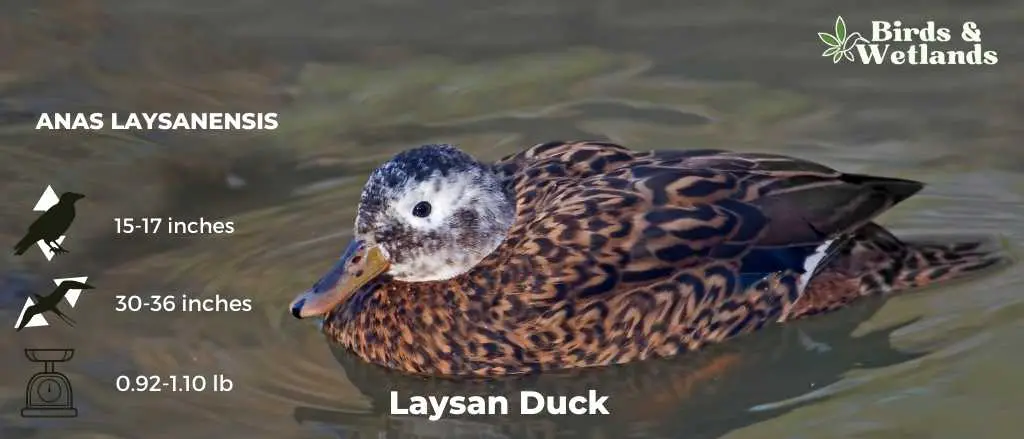
Laysan Duck
Listen to Laysan Duck
The Laysan duck is a medium-sized duck that is endangered due to its limited habitat, which consists of small islands off the coast of Hawaii, as well as its inability to fly far distances.
They have a yellowish-brown breast, a brownish chestnut body, and a dark brown head with white stripes across their face.
Laysan ducks live in Hawaii, which has been their home for thousands of years. They can be found on most islands in the Hawaiian chain, including Oahu, Molokai, Kauai and Niihau. The ducks are known to inhabit freshwater ponds and wetlands that have at least one source of food nearby (such as a farm or garden).
They spend their days swimming around and diving for clams, snails, algae and other sea creatures.
Laysan Ducks, found on the Hawaiian island of Laysan, nest in colonies that are made up of thousands of individuals. The ducks live in rock crevices or under shrubs where they find protection from predators while they nest and lay their eggs.
These ducks are very territorial, only allowing one male to mate with one female at a time. Once they mate, they stay together until the female lays her eggs. After that, they go their separate ways until the next mating season begins.
The Laysan Duck is considered to be one of the most endangered species of waterfowl on Earth. Due to their small population size (only about 1,000 birds remain), these animals are currently listed as threatened by the U.S. Fish and Wildlife Service.
Scientific Name: Anas laysanensis
Height: 38.1 to 43.2 centimeters (15 to 17 inches)
Wingspan: —
Weight: 420 to 500 grams (14.8 to 17.6 ounces)
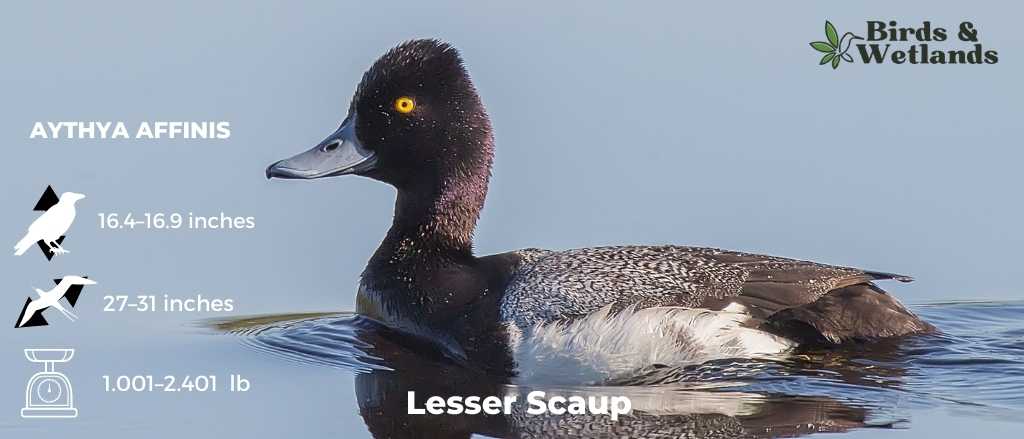
Lesser Scaup
Listen to Lesser Scaup
The Lesser Scaup is a small diving duck native to North America and winter in Central America. Lesser Scaups are smaller than Greater Scaups.
Males have golden yellow eyes. Their chests and heads are black with a purple sheen. Their sides are white while their backs have an intricate pattern of gray and white feathers.
Females have darker heads than males. They have gray sides and brown bodies with a white patch around the base of their bills.
The Lesser Scaup’s habitat is typically freshwater lakes, rivers, and streams. They can also be found on large ponds and reservoirs with plenty of aquatic vegetation.
Lesser Scaups eat mostly fish but also insects and small crustaceans, which they find by diving beneath the surface of the water for up to 40 seconds at a time.
Lesser scaups breed in ponds and lakes across Canada and much of the northern United States from late April through May. They usually nest in colonies with other species such as Mallards and Common Goldeneyes.
The Lesser Scaup is not considered to be endangered or threatened and is currently listed as Least Concern by the International Union for Conservation of Nature (IUCN).
Scientific Name: Aythya affinis
Height: 41.7–43 cm (16.4–16.9 in)
Wingspan: 68–78 cm (27–31 in)
Weight: 454–1,089 g (1.001–2.401 lb)
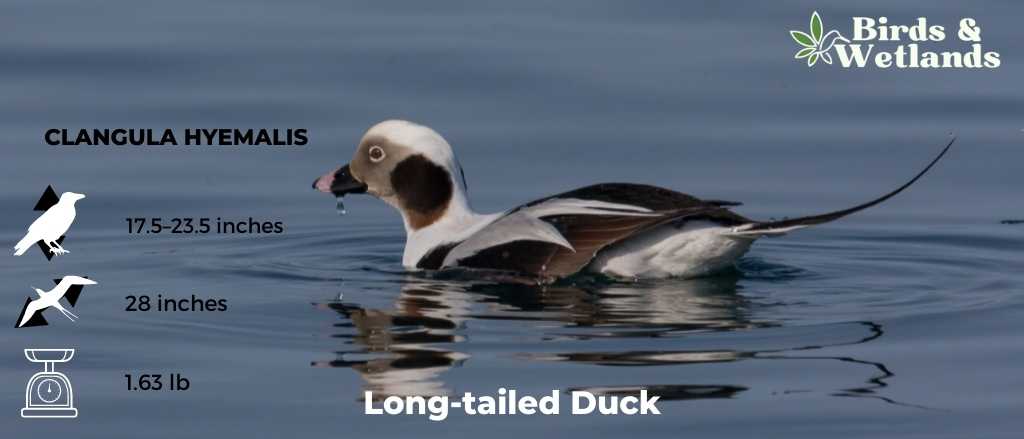
Long-tailed Duck
Listen to Long-tailed Duck
Long-tailed Ducks are species of duck that are native to Australia and New Zealand. They are named for their long, narrow tail feathers, which can be over 30% longer than the rest of their body. It has a black bill, brown eyes, and grayish-brown feathers on its back and wings. The underside of the bird is white in color.
The Long-tailed Duck eats aquatic plants, seeds, insects, snails, mollusks, crustaceans, fish eggs, and small fish. They can dive up to 60 feet below the surface.
These species of duck prefer to live in areas where there are plenty of lakes and ponds for them to feed on. They are also known for being very territorial so they tend not to share their space with other species unless they have no choice but to or if they’re trying to breed.
They are migratory birds, traveling from Canada to Europe during the summer months before returning south for winter months in North America or Asia.
They can be found in Europe, Asia, North America, and parts of South America. They breed in freshwater lakes from May through July or August depending on where they live. They migrate to southern latitudes during the winter months to avoid freezing temperatures.
Long-tailed Ducks have a current population of roughly 2 million individuals worldwide—that’s down from an estimated 4 million during the 1980s.
Scientific Name: Clangula hyemalis
Length: 440–600 mm (17.5–23.5 in)
Wingspan: 710 mm (28 in)
Weight: 740 g (1.63 lb)

Mallard
Listen to Mallard
Mallards are native to the Northern Hemisphere. These ducks live in many parts of the United States and Canada.
Male mallards have a lustrous green head, with a white collar that sets off his dark chestnut breast. His back is a rich brown, and his tail is adorned with iridescent blue and green feathers.
The female mallard has mottled brown overalls with an orange and brown bill.
The Mallard’s diet consists mostly of seeds, fruit, and insects. These ducks have been known to consume small rodents when available. They usually feed at night in shallow water or on land near water sources.
Most Mallards live in wetlands such as ponds, lakes, and rivers. They also inhabit saltwater environments close to lands such as bays and estuaries.
Mallards are also social birds that travel in flocks during the breeding season. Males and females form monogamous pairs during the winter months when they migrate southward to warmer climates.
Scientific Name: Anas platyrhynchos
Height: 50–65 cm (20–26 in)
Wingspan: 81–98 cm (32–39 in)
Weight: 0.7–1.6 kg (1.5–3.5 lb)
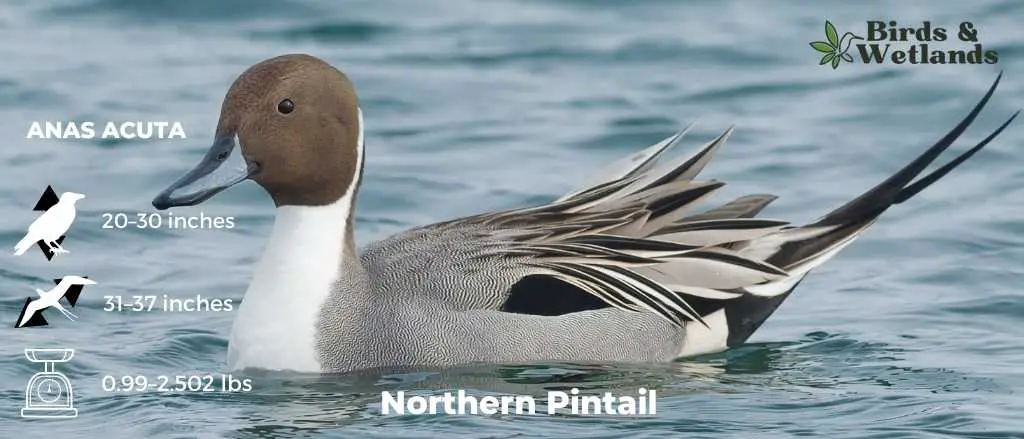
Northern Pintail
Listen to Northern Pintail
Northern Pintails are slender ducks with relatively long necks and tails. The male has a cinnamon-brown head, a white breast and throat. While males have gray bodies, females have rufous-brown plumage. Both sexes have a pale black-gray bill.
The Northern Pintail is a migratory bird that nests on or near open water with some vegetation nearby.
Northern Pintails feed on aquatic plants such as bulrush roots, pondweeds, and sedges. They also feed on seeds from different plants like grass, insects such as dragonflies, fish and other small animals worms and tadpoles.
There are approximately 1 million Northern Pintails left in the wild today.
Scientific Name: Anas acuta
Height:
Male: 59–76 cm (23–30 in)
Female: 51–64 cm (20–25 in)
Wingspan: 80–95 cm (31–37 in)
Weight:
Male: 450–1,360 g (0.99–3.00 lb)
Female: 454–1,135 g (1.001–2.502 lb)
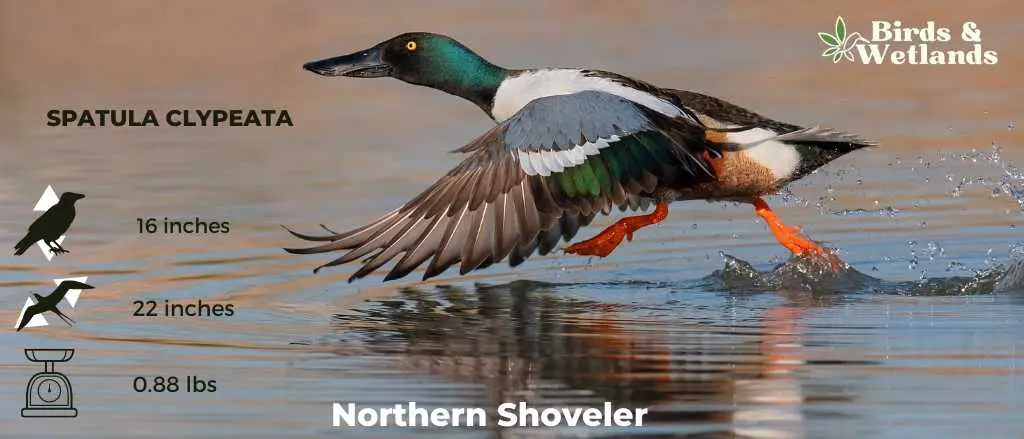
Northern Shoveler
Listen to Northern Shoveler
The northern shoveler, often known as the shoveler in the United Kingdom, is a common and ubiquitous duck. With its brown head and neck and breast, greenish-yellow bill and wings, white breast and belly, and the dark greenback, and black tail feathers, it’s hard to mistake for any other duck species.
This duck lives in freshwater ponds, marshes, lakes, rivers, and streams but will also sometimes inhabit brackish water areas where the water has a high salt content. It breeds in North America from Canada to Mexico, migrating south for the winter months.
The Northern Shoveler’s diet consists primarily of aquatic plants like duckweed and water lettuce. It also eats insects, worms, crustaceans, and mollusks if they can find them in the water.
Wintering in southern Europe, the Indian subcontinent, Southeast Asia, Central, the Caribbean, and northern South America, it breeds in northern Europe, through the Palearctic, and across much of North America.
Scientific Name: Spatula clypeata
Height: 16 in (41 cm)
Wingspan: 22-inch (560 mm)
Weight: 14 oz (400 g)
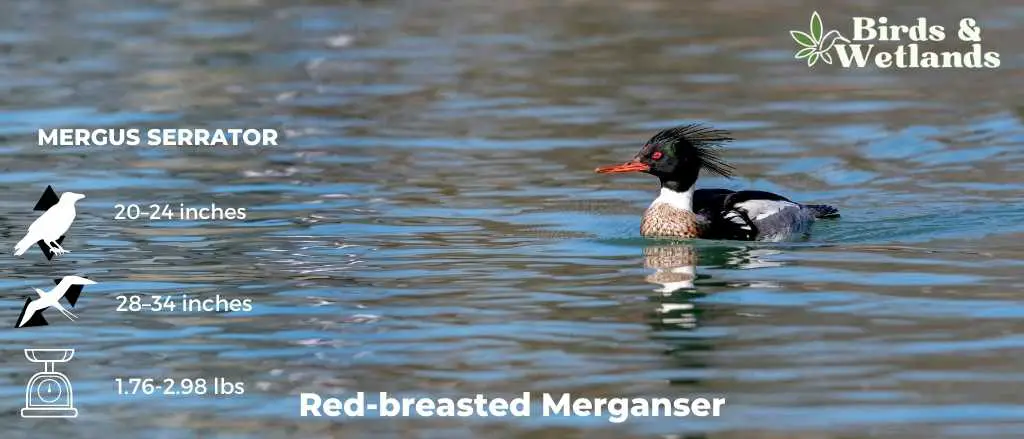
Red-breasted Merganser
Listen to Red-breasted Merganser
Red-breasted Mergansers have long, slender bodies with equally long, thin bills and gray flanks.
Breeding males have cinnamon chests, red eyes, white neck bands and shaggy-looking green heads. The back and wings are dark brown, with some iridescent feathering on the wings.
Non-breeding males and females have mostly grayish bodies, spiky reddish-brown heads and brown eyes.
Red-breasted Mergansers feed on small fish by diving into the water. They use their wings to propel themselves forward like penguins do when swimming underwater.
Red-breasted Mergansers breed in boreal forests of North America. They inhabit lakes, rivers, and ponds where they can search for food and protect themselves against predators.
Red-breasted Mergansers are not endangered or threatened at this time because it has a very large population of over 8 million birds worldwide.
Scientific Name: Mergus serrator
Length: 51–62 cm (20–24 in)
Wingspan: 70–86 cm (28–34 in)
Weight: 28.2 to 47.6 oz (800 to 1,350 g)
Redhead
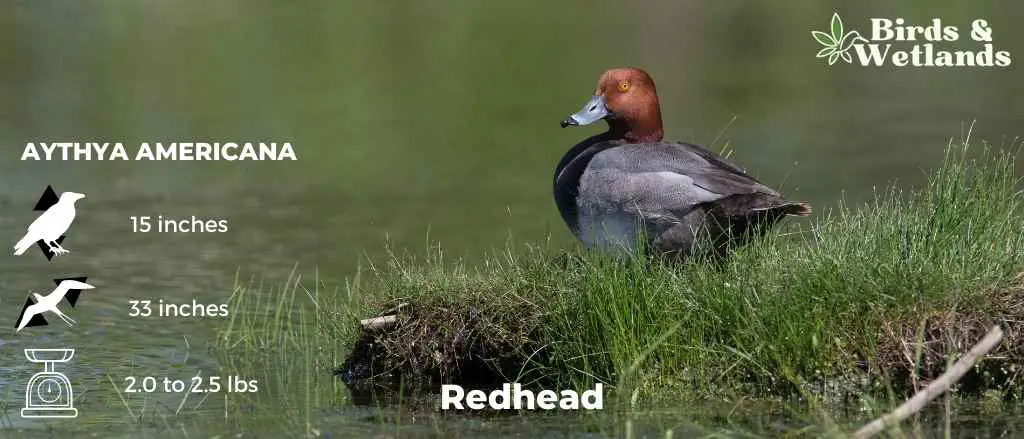
Redhead
Listen to Redhead
The redhead is a medium-sized diving duck. On average, it weighs 2.5 lbs (1.1 kgs). This duck species is related to the common pochard and canvasback.
Both males and females have a steep forehead. Males have cinnamon-red heads with black-tipped gray bills, black chests and gray bodies. Females have brown bodies and pale faces.
Redheads can be found throughout North America, with the exception of southern Mexico and parts of the southeastern United States. They are most common in coastal areas and large rivers. In fact, many people mistake them for musk ducks when they see them in freshwater habitats.
Redheads are migratory birds and migrate south in the winter. Many flocks of redheads spend winters in Florida, Texas, Louisiana, Oregon, California and along the Gulf of Mexico.
Redheads primarily live in wetlands, lakes, rivers, coastal marshes, estuaries and bays. These ducks prefer to inhabit areas near the water that is deep enough to provide a variety of food sources such as aquatic plants and small fishes.
Scientific Name: Aythya americana
Height: 37 cm (15 in)
Weight: 2.0 to 2.5 lbs
Wingspan: 84 cm (33 in)
Ring-necked Duck (Aythya collaris)
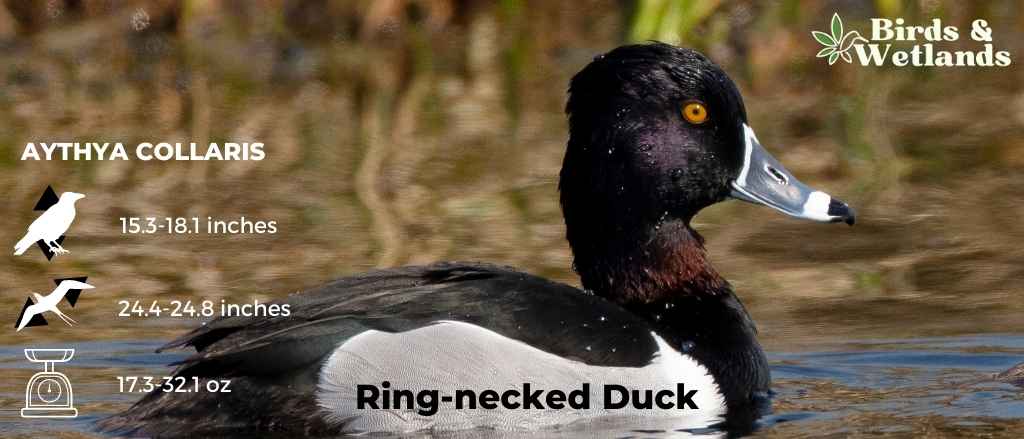
Ring-necked Duck
Listen to Ring-Necked Duck
The ring-necked duck is a medium-sized diving duck commonly found in lakes and ponds of North America, Central America and northern regions of South America.
Ring-necked ducks have a white band and a black tip at the end of their gray bills. Males have glossy black heads and yellow eyes while females have grayish brown heads and dark eyes.
Breeding populations of ring-necked ducks are found throughout the northern United States and Canada. A few flocks of these ducks breed in the eastern region of Canada.
During winter, flocks of ring-necked ducks migrate to the warmer climates of the southern United States, Central America and northern regions of South America.
Ring-necked ducks inhabit rivers, bays, ponds and lakes where they feed on submerged vegetation. The bulk of their diet consists of stems, seeds, tubers and leaves of pondweed, wild celery and water lilies. When available, they also consume grains such as wild rice and millet. As omnivores, ring-necked ducks are also known to feed on aquatic invertebrates, worms, leeches, snails, nymphs and dragonflies.
Scientific Name: Aythya collaris
Height: 15.3-18.1 in (39-46 cm)
Wingspan: 24.4-24.8 in (62-63 cm)
Weight: 17.3-32.1 oz (490-910 g)
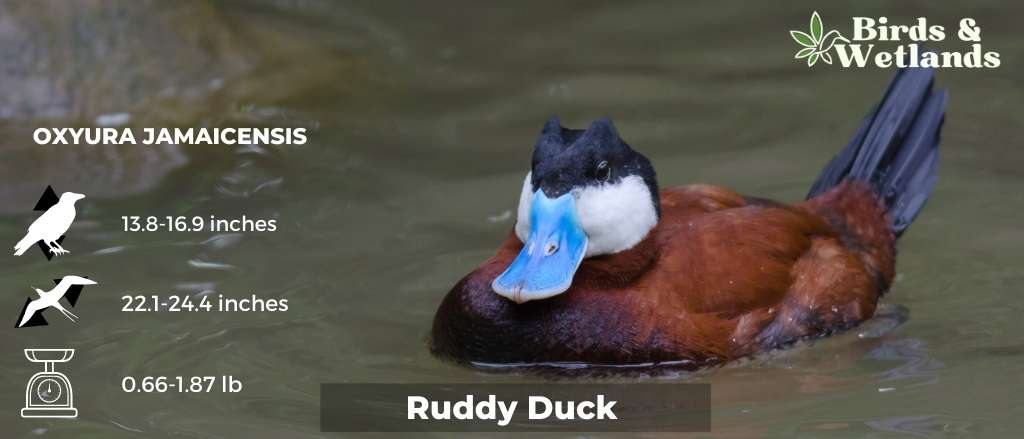
Ruddy Duck
Listen to Ruddy Duck
Ruddy Ducks, commonly referred to as Ruddies, are medium-sized ducks of North America.
Breeding males in their breeding plumage are unlike any other duck you’ve seen. They have thick necks, white cheeks and bright blue bills.
Females and non-breeding males are soft orange-brown with a dark, scoop-like bill.
Ruddy Ducks are omnivorous, eating plants and insects as well as fish and small animals. It eats insects, grains, seeds, and aquatic plants. They are monogamous animals; they mate for life and have one clutch per year of 4-6 eggs that hatch after 25 days.
Ruddy Ducks frequently move in small groups of 5–15 birds at night. They’re also very sociable animals.
Ruddy Ducks live in freshwater lakes, ponds, rivers, marshes, and swamps. They are migratory birds that spend the winter in South America. They are typically found in freshwater lakes and marshes during the breeding season (April through August), but they can also be seen on rivers or coasts during migration or wintering months (October through February).
Scientific Name: Oxyura jamaicensis
Length: 13.8-16.9 in (35-43 cm)
Wingspan: 22.1-24.4 in (56-62 cm)
Weight: 10.6-30.0 oz (300-850 g)
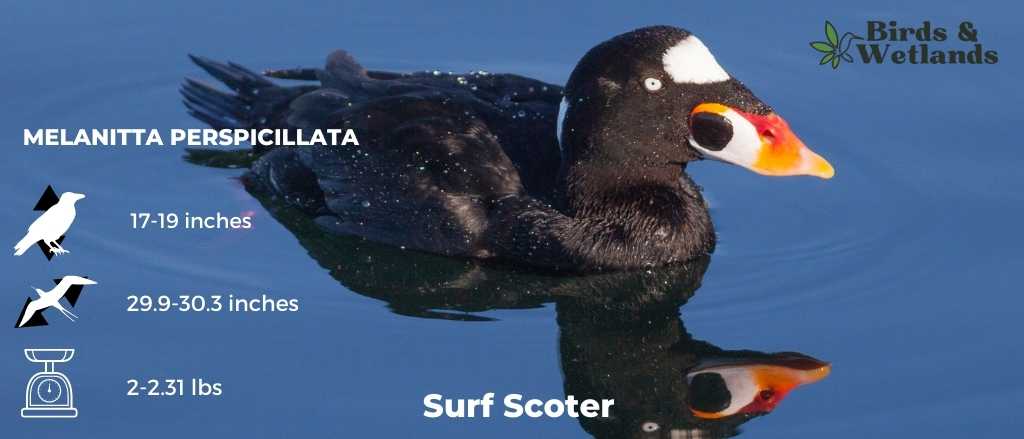
Surf Scoter
Listen to Surf Scoter
The surf scoter is a medium-sized sea duck native to North America. Males are mostly black with white patches at the back of the neck and crown. Their sloping orange bills. Females are mostly grayish brown with dark-sloping bills.
Surf scoters breed exclusively in North America, particularly in the northern regions of Canada and Alaska. Most flocks of surf scoters spend winters along the Atlantic and Pacific coasts of North America.
Surf scoters live near oceans and other large bodies of water. As sea ducks, surf scoters almost exclusively prey on creatures near or on the sea floor called benthic invertebrates. These creatures include marine snails, mussels, clams, small crabs and hydrozoans. They also feed on aquatic plants on occasion.
Scientific Name: Melanitta perspicillata
Length:
Male: 48 cm (19 in)
Female: 44 cm (17 in)
Wingspan: 29.9-30.3 in (76-77 cm)
Weight:
Male: 1,050 g (2.31 lb)
Female: 900 g (2.0 lb)
Tufted Duck (Aythya fuligula)
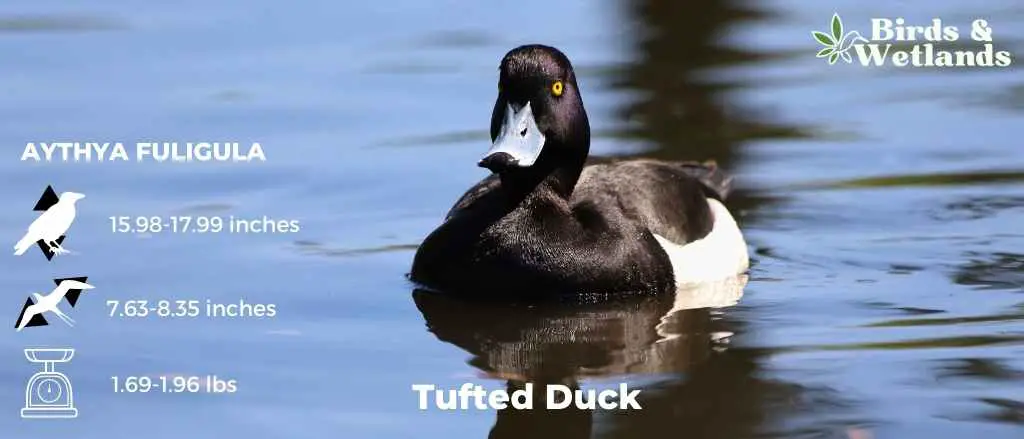
Tufted Duck
Listen to Tufted Ducks
Males are all black with white flanks, blue-gray bills and golden yellow eyes. They have an obvious head tuft and a thin crest on the back of their head. Females have dark chocolate brown overalls, with heads that are slightly darker than their bodies.
Tufted ducks breed in the northern regions of Eurasia. They form large flocks when migrating south for the winter. They have been spotted along the east and west coasts of the United States and Canada.
Tufted ducks live near freshwater lakes, coastlines, ponds and rivers. They prefer areas with tall vegetation to conceal their nests.
When it comes to diet, tufted ducks love mussels and other small mollusks. Occasionally, they eat plants and grass.
Scientific Name: Aythya fuligula
Height: Male: 40.6-45.7 cm Female: 40.6-45.7 cm
Wingspan: Male: 20.2-21.2 cm Female: 19.4-20.7 cm
Weight: Male: 889.6 g Female: 768.3 g
Where to Watch Ducks in HI?
Kealia Pond National Wildlife Refuge is one of Hawaii’s best spots to see ducks. Various duck species, including Hawaiian Ducks, Mallards, and Northern Pintails, call the refuge home. Visitors can also watch wading birds, including Great Egrets and White-faced Ibises. The ducks are best seen early or late afternoon while feeding on the pond’s surface. Hawaiian waterbirds can be observed swimming and preening on the water’s surface, even in the middle of the day.
If you want to watch Hawaiin Ducks, you should check out Hanalei National Wildlife Refuge.
Are There Any Resident Ducks in HI?
Most ducks in the state of Hawaii don’t migrate in the winter. The state’s relatively warm climate and mild winters allow Hawaii’s native waterbirds to stay in the state all year long.
Duck Hunting in Hawaii
Duck hunting is not allowed in Hawaii.
Final Thoughts on Ducks in HI
The main Hawaiian Islands are a birder’s paradise. With more than 350 species of birds on its six main islands, the Aloha state offers some of the best bird-watching experiences in the world.
The Hawaiian Islands are home to iconic native bird species such as the nene (Hawaiian goose), Hawaiian Duck, and Laysan Duck. Many migratory birds, such as the kolea (plover) and amakihi (honeycreeper), visit Hawaii’s islands.

